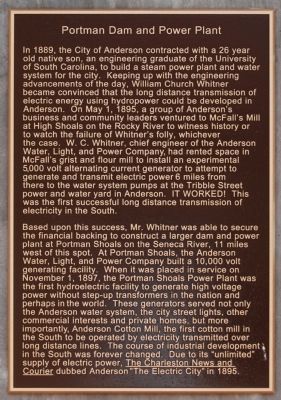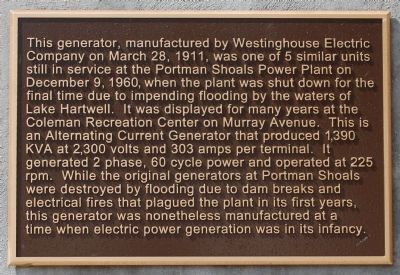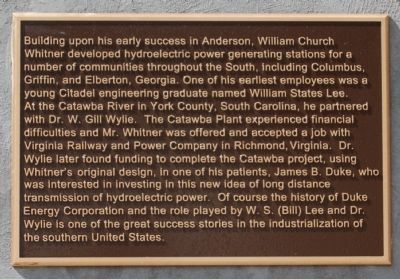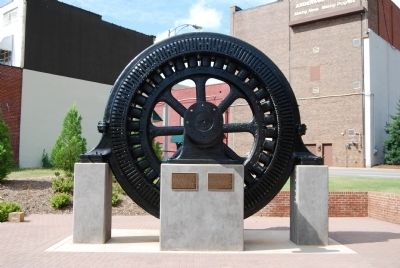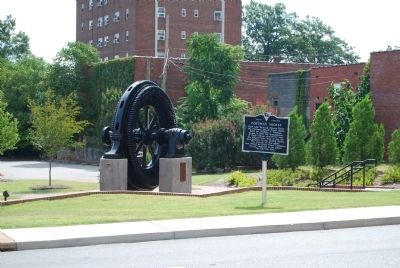Anderson in Anderson County, South Carolina — The American South (South Atlantic)
Portman Dam and Power Plant
[Front Marker]:
In 1889, the City of Anderson contracted with a 26 year old native son, an engineering graduate of the University of South Carolina, to build a steam power plant and water system for the city. Keeping up with the engineering achievements of the day, William Church Whitner became convinced that the long distance transmission of electric energy using hydropower would be developed in Anderson. On May 1, 1895, a group of Anderson's business and community leaders ventured to McFall's Mill at High Shoals on the Rocky River to witness history or to watch Whitner's folly, whichever the case. W.C. Whitner, chief engineer of the Anderson Water, Light, and Power Company, had rented space in McGill's grist and flour mill to install an experimental 5,000 volt alternating current generator to attempt to generate and transmit electric power 6 miles from there to the water system pumps at the Tribble Street power and water yard in Anderson. It Worked! This was the first successful long distance transmission of electricity in the South.
Based upon this success, Mr. Whitner was able to secure the financial backing to construct a larger dam and power plant at Portman Shoals on the Seneca River, 11 miles west of this spot. At Portman Shoals, the Anderson Water, Light, and Power Company built a 10,000 volt generator facility. When it was placed in service on November 1, 1897, the Portman Shoals Power Plant was the first hydroelectric facility to generate high voltage power without step-up transformers in the nation and perhaps in the world. These generators served not only the Anderson water system, the city street lights, other commercial interests and private homes, but more importantly, Anderson Cotton Mill, the first cotton mill in the South to be operated by electricity transmitted over long distance lines. The course of industrial development in the South was forever changed. Due to its "unlimited" supply of electric power, The Charleston News and Courier dubbed Anderson "The Electric City" in 1895.
[Reverse, Leftmost Marker]:
This generator, manufactured by Westinghouse Electric Company on March 28, 1911, was one of 5 similar units still in service at the Portman Shoals Power Plant on December 9, 1960, when the plant was shut down for the final time due to impending flooding by the waters of Lake Hartwell. It was displayed for many years at the Coleman Recreation Center on Murray Avenue. This is an Alternating Current Generator that produced 1,390 KVA at 2,300 volts and 303 amps per terminal. It generated 2 phase, 60 cycle power and operated at 225 rpm. While the original generators at Portman Shoals were destroyed by flooding due to dam breaks
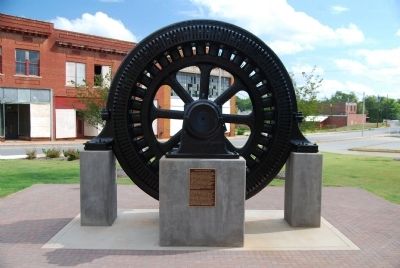
Photographed By Brian Scott, August 23, 2008
2. Portman Dam and Power Plant Marker - Front
Unfortunately, Generation Park did not go up smoothly. The park was financed by TBA 100, a privately donated group which seeks to raise $100,000 per year for green space projects in Anderson. This was their first project. They were opposed by a local citizen who felt that the generator wheel was better kept in a museum, out of the elements and in restored to working condition.
[Reverse, Rightmost Marker]: Building upon his early success in Anderson, William Church Whitner developed hydroelectric power generating stations for a number of communities throughout the South, including Columbus, Griffin, and Elberton, Georgia. One of his earliest employees was a young Citadel engineering graduate named William States Lee. At the Catawba River in York County, South Carolina, he partnered with Dr. W. Gill Wylie. The Catawba Plant experienced financial difficulties and Mr. Whitner was offered and accepted a job with Virginia Railway and Power Company in Richmond, Virginia. Dr. Wylie later found funding to complete the Catawba project, using Whitner's original design, in one of his patients, James B. Duke, who was interested in investing in this new idea of long distance transmission of hydroelectric power. Of course, the history of Duke Energy Corporation and the role played by W.S. (Bill) Lee and Dr. Wylie is one of the great success stories in the industrialization of the southern United States.
Erected 2008 by To Better Anderson 100.
Topics. This historical marker is listed in this topic list: Industry & Commerce. A significant historical month for this entry is March 1897.
Location. 34° 30.224′ N, 82° 38.915′ W. Marker is in Anderson, South Carolina, in Anderson County. Marker is at the intersection of North McDuffie Street and Whitner Street on North McDuffie Street. Marker is located near Generator Park. Touch for map. Marker is in this post office area: Anderson SC 29621, United States of America. Touch for directions.
Other nearby markers. At least 10 other markers are within walking distance of this marker. Portman Shoals (here, next to this marker); G.F. Tolly Building -- c. 1910 (a few steps from this marker); Masonic Temple -- 1889 (about 400 feet away, measured in a direct line); Fant's Book Store -- 1851 (about 400 feet away); Blue Ridge Railroad Passenger Station -- c. 1913 (about 500 feet away); The Four Way Test (about 500 feet away); William Church Whitner (about 500 feet away); Anderson County Court House -- 1898 (about 500 feet away); Beyond Commerce: Building a Legacy of Hard Work (about 500 feet away); Anderson: "The Electric City" (about 500 feet away). Touch for a list and map of all markers in Anderson.
Additional commentary.
1. Plutonian Darkness
Andersonians had not realized how much they had come to depend on electrical current when, in the fall of 1901, a great freshet swept away the dam at Portman Shoals. Industry was almost paralyzed, the streets were plunged into 'plutonian darkness," and old abandoned oil lamps had to be brought out to light houses and public buildings. In September 1902, the new dam was completed and when the lights were turned on again after so many months, "grown people behaved like children at Christmas time." (Source: Anderson County Sketches, The Anderson County Tricentennial Committee, 1968)
— Submitted August 24, 2008, by Brian Scott of Anderson, South Carolina.
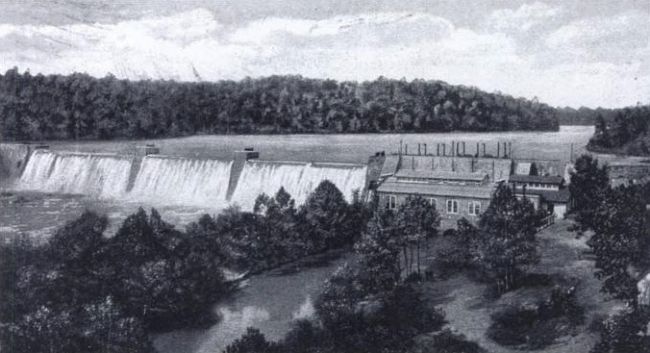
South Carolina Postcards, Vol. IX: Anderson County, by Howard Woody, circa 1920
7. Portman Shoals Power Plant, Seneca River
W.C. Whitner conceived the idea of the long distance transmission of electric power in 1894. First a small plant was established at High Shoals on the Ricky River six miles from Anderson. It transmitted 200 electrical horsepower from 5,000-volt generators. Then the Portman Shoals Power Plant on the Seneca River, a 10-mile distance, was built by the Anderson Light & Power Company. Construction began in 1896. It used Stanley Electric Company's 11,000-volt generators. The Portman Dam, swept away in December of 1901, was rebuilt and returned to service in September 1902. The plant caused Anderson to be called the "Electric City."
Credits. This page was last revised on December 11, 2019. It was originally submitted on August 24, 2008, by Brian Scott of Anderson, South Carolina. This page has been viewed 5,735 times since then and 205 times this year. Photos: 1, 2, 3, 4, 5, 6. submitted on August 24, 2008, by Brian Scott of Anderson, South Carolina. 7. submitted on September 23, 2010, by Brian Scott of Anderson, South Carolina. • Kevin W. was the editor who published this page.
